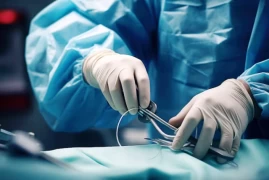
Vaginal PRP Application
- Vaginal PRP Application
- What is PRP?
- For What Purposes Is PRP Used in Gynecology and Obstetrics?
- What are the Purposes of Vaginal PRP Application?
- What are the Stages of Vaginal PRP Application?
- Is There an Age Limit for PRP Use?
- Are there any cases where the use of PRP is objectionable?
- Can PRP Be Used During Pregnancy?
What is PRP?
PRP stands for platelet-rich plasma. It is a regenerative medicine technique that involves using a patient's own blood to stimulate healing and tissue regeneration.
To create PRP, a small amount of the patient's blood is drawn and then processed in a centrifuge to separate out the platelets and growth factors from other components of the blood. The resulting platelet-rich plasma is then injected or applied topically to the area that requires treatment.
PRP is believed to work by releasing growth factors that stimulate the body's natural healing processes, promoting tissue regeneration, and reducing inflammation. It has been used to treat a wide range of conditions, including musculoskeletal injuries, osteoarthritis, hair loss, and skin rejuvenation.
While there is some evidence to suggest that PRP therapy may be effective for certain conditions, it is important to note that the evidence is still limited and more research is needed to fully understand its benefits and risks. Furthermore, PRP is not approved by the FDA for all uses, and it is important for patients to discuss the potential risks and benefits of the procedure with a qualified healthcare provider.
For What Purposes Is PRP Used in Gynecology and Obstetrics?
PRP therapy has gained interest in the field of gynecology and obstetrics in recent years as a potential treatment for various conditions. Here are some of the ways PRP is used in gynecology and obstetrics:
- Vulvovaginal atrophy (VVA): VVA is a common condition that occurs as a result of decreased estrogen levels. It can cause vaginal dryness, irritation, and pain during sexual intercourse. PRP therapy has been used to improve vaginal lubrication, elasticity, and overall function in women with VVA.
- Urinary incontinence: PRP therapy has been used to treat urinary incontinence by strengthening the muscles that control the bladder.
- Pelvic pain: PRP therapy has been used to treat pelvic pain caused by conditions such as endometriosis or pelvic adhesions.
- Sexual dysfunction: PRP therapy has been used to treat sexual dysfunction in women by promoting vaginal tissue regeneration and improving blood flow to the area.
- Perineal tears: PRP therapy has been used to promote healing and reduce scarring in women who have experienced perineal tears during childbirth.
It is important to note that the use of PRP in gynecology and obstetrics is still considered experimental and the evidence is limited. More research is needed to fully understand the safety and effectiveness of the treatment for these conditions. Patients should discuss the potential risks and benefits of PRP therapy with a qualified healthcare provider before undergoing the procedure.
What are the Purposes of Vaginal PRP Application?
The use of PRP therapy for vaginal rejuvenation and other gynecological conditions has gained interest in recent years. Here are some of the purposes of vaginal PRP application:
- Vaginal dryness: PRP therapy has been used to improve vaginal lubrication in women experiencing vaginal dryness, which can be caused by hormonal changes or other factors.
- Vaginal laxity: PRP therapy has been used to improve vaginal tightness and elasticity, which can become stretched out over time due to aging, childbirth, or other factors.
- Pain during sexual intercourse: PRP therapy has been used to reduce pain during sexual intercourse caused by vaginal atrophy or other conditions.
- Treatment of urinary incontinence: PRP therapy has been used to strengthen the muscles that control the bladder, which can improve urinary incontinence in women.
- Treatment of vulvovaginal atrophy (VVA): VVA is a common condition that occurs as a result of decreased estrogen levels, causing vaginal dryness, irritation, and pain during sexual intercourse. PRP therapy has been used to improve vaginal lubrication, elasticity, and overall function in women with VVA.
It is important to note that the use of PRP for vaginal rejuvenation and other cosmetic purposes is considered off-label and not approved by the FDA. The evidence supporting the use of PRP for these purposes is still limited, and more research is needed to fully understand its benefits and risks. Patients should discuss the potential risks and benefits of PRP therapy with a qualified healthcare provider before undergoing the procedure.
What are the Stages of Vaginal PRP Application?
The stages of vaginal PRP application can vary depending on the specific technique used and the healthcare provider performing the procedure. However, here is a general overview of the stages involved in vaginal PRP application:
- Consultation: The first stage involves a consultation with a qualified healthcare provider to determine if vaginal PRP therapy is appropriate for the patient. The healthcare provider will review the patient's medical history, perform a physical examination, and discuss the potential risks and benefits of the procedure.
- Blood draw: If the patient is a candidate for vaginal PRP therapy, a small amount of blood will be drawn from their arm. The blood is then placed in a centrifuge, which separates the platelets and growth factors from other components of the blood.
- Preparation of the PRP: The platelet-rich plasma is then processed and prepared for application. This can involve adding activating agents to the PRP to enhance its regenerative properties.
- Application of the PRP: The PRP is then applied to the vaginal walls using a specialized applicator. The PRP can be injected into the vaginal tissue or applied topically.
- Recovery: The patient may experience some mild discomfort or soreness following the procedure, but it is generally well-tolerated. Patients can typically return to normal activities the same day, but should avoid sexual activity for a few days.
- Follow-up: The healthcare provider will schedule a follow-up appointment to monitor the patient's progress and determine if additional treatments are needed.
It is important to note that the exact stages of vaginal PRP application can vary depending on the specific technique used and the healthcare provider performing the procedure. Patients should discuss the details of the procedure with their healthcare provider before undergoing the treatment.
Is There an Age Limit for PRP Use?
There is no specific age limit for the use of PRP therapy, as the treatment can be used for a variety of conditions in patients of different ages. However, the appropriateness of PRP therapy may depend on a variety of factors, such as the patient's overall health, the condition being treated, and the patient's individual medical history.
For example, PRP therapy may be more appropriate for patients who have not responded well to other treatments, or for those who are not good candidates for other therapies due to medical reasons or other factors. Additionally, some conditions that PRP therapy is used to treat, such as vulvovaginal atrophy or urinary incontinence, are more common in postmenopausal women, who may be of an older age.
It is important for patients to discuss the potential benefits and risks of PRP therapy with a qualified healthcare provider, who can help determine if the treatment is appropriate based on their individual circumstances. The healthcare provider may also consider factors such as the patient's age, medical history, and overall health when making a decision about whether PRP therapy is an appropriate treatment option.
Are there any cases where the use of PRP is objectionable?
There are certain cases where the use of PRP therapy may not be appropriate, or where the patient or healthcare provider may object to its use. Some of these cases may include:
- Active infections: PRP therapy should not be used in patients who have an active infection, as it can increase the risk of spreading the infection or causing further complications.
- Bleeding disorders: PRP therapy involves drawing blood and processing it to isolate the platelet-rich plasma. Patients with bleeding disorders or those taking anticoagulant medications may not be good candidates for the procedure.
- Cancer: Patients who have been diagnosed with cancer, or who have a history of cancer, may not be good candidates for PRP therapy. The use of PRP therapy in cancer patients is still being studied, and there is limited research on its safety and effectiveness.
- Allergies: Patients who have allergies to components of blood or blood products may not be good candidates for PRP therapy.
- Pregnancy: The safety of PRP therapy during pregnancy is not well-established, and it is generally not recommended for pregnant women.
- Certain medical conditions: Patients with certain medical conditions, such as autoimmune disorders or certain skin conditions, may not be good candidates for PRP therapy.
It is important for patients to discuss their individual medical history and any concerns with their healthcare provider before undergoing PRP therapy. The healthcare provider can help determine if PRP therapy is an appropriate treatment option, and can recommend alternative treatments if necessary.
Can PRP Be Used During Pregnancy?
The use of PRP (platelet-rich plasma) therapy during pregnancy is not well-established, and its safety for both the mother and the developing fetus is not fully understood. As a result, PRP therapy is generally not recommended for pregnant women.
There is limited research on the use of PRP therapy during pregnancy, and the few studies that have been conducted have focused primarily on its use for musculoskeletal conditions, such as low back pain or joint pain, rather than gynecological or obstetric applications.
It is important for pregnant women to discuss any potential treatments or procedures with their healthcare provider, including the use of PRP therapy. The healthcare provider can help weigh the potential benefits and risks of the treatment, and recommend alternative treatments if necessary. In general, it is important to avoid unnecessary medical interventions during pregnancy, particularly those that may pose a risk to the developing fetus.




